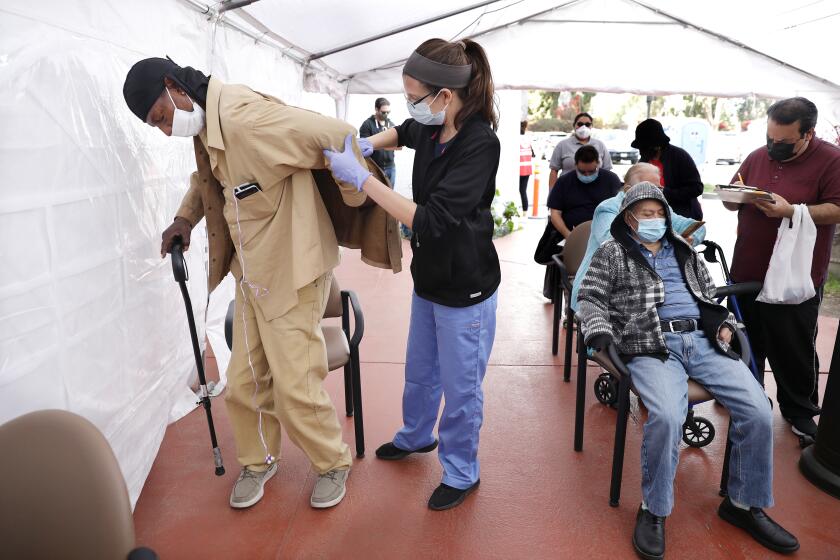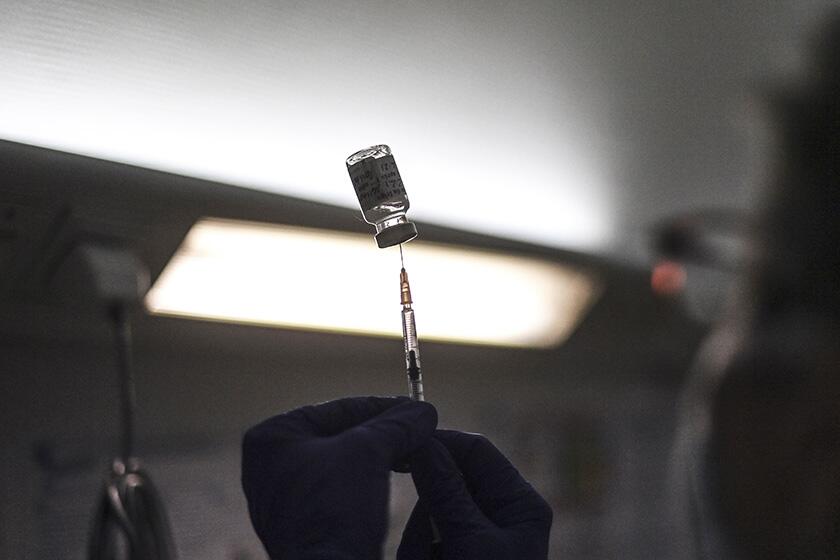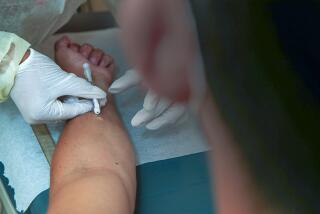L.A. COVID-19 vaccine supply crunch makes getting a first shot a continued challenge

- Share via
Appointments to get a COVID-19 vaccination remain a precious commodity in Los Angeles County this week, as many slots are reserved for second doses and officials continue to contend with a supply crunch.
At county-run sites — the Pomona Fairplex, the Forum in Inglewood, Cal State Northridge, the county Office of Education, Six Flags Magic Mountain, the Balboa Sports Complex, El Sereno Recreation Center and the Antelope Valley Health Center — “the remainder of appointments this week are dedicated to providing second doses,” the L.A. County Department of Public Health tweeted Sunday.
Only about 44.5% of this week’s supply of 280,000 doses will be available for first shots, officials said Monday.
However, the bottleneck is not expected to be anywhere near as severe at sites run by the city of Los Angeles, such as those at San Fernando Park, Hansen Dam, Crenshaw Christian Center, Lincoln Park, Pierce College, USC University Park and Dodger Stadium.
City officials say they will offer more than 70,000 shots this week, with about 50,000 available for first doses.
In the race to improve vaccination rates in California’s most vulnerable areas, community groups are leading the charge.
“Each Angeleno vaccinated moves us closer to reopening our businesses, getting kids back in the classroom and returning to the embrace of family and friends,” Mayor Eric Garcetti said in a statement. “Our city is determined to get shots into people’s arms as swiftly and safely as possible, because we know that’s the best path to ending this pandemic once and for all.”
Two of the COVID-19 vaccines being used in the United States — from Pfizer-BioNTech and Moderna — require two doses, administered weeks apart. As a result, health officials have for months had to balance the desire to vaccinate as many people as possible, as quickly as possible, with ensuring that there’s sufficient supply down the line for people to complete their two-shot regimen.
For much of the COVID-19 vaccine rollout, health officials in L.A. County and across the state have been singing a similar refrain: that the supply of doses coming in is not only insufficient to meet demand but much less than providers can reliably administer.
Parents say health concerns and an unsatisfactory hybrid learning plan are fueling their reluctance.
In L.A. County, officials say they could dole out roughly 634,000 doses this week alone, but they’ve never come close to receiving that many.
“Our efforts are slowed by the continued lack of vaccine supply,” county Public Health Director Barbara Ferrer said Monday.
Ferrer said available appointments are still filling up “within hours of being released,” and that’s unlikely to change as long as doses remain in short supply.
“We have about 5½ million people in L.A. County that are eligible to get vaccinated, and most of them are going to need two doses,” she said during a briefing. “So we have a ways to go.”
But, she added, health officials are “grateful that we have so many people interested in getting vaccinated” and “are anxious for us to get to the time and place where we have ample vaccine, so that it’s very easy for every single person to have access.”
California expects to receive roughly 1.8 million doses this week — up slightly from last week’s allotment, according to Gov. Gavin Newsom.
But weekly shipments of that size aren’t enough to keep up with the state’s breakneck vaccination pace.
The last eight days have seen the highest single-day totals of shots administered statewide, data compiled by The Times show. During that stretch, providers doled out 3.1 million doses, an average of almost 388,000 per day.
Overall, more than 14.8 million doses of vaccine — about 81% of the supply that has been delivered to local public health departments and medical providers — have been administered statewide, according to the California Department of Public Health.
And many officials are striking an optimistic tone that the vaccine valve may be significantly loosened in the not-too-distant future.
Earlier this month, President Biden said restrictions on who could make a COVID-19 vaccine appointment would be lifted nationwide by May 1, as supply is expected to be sufficient to meet demand.
And Newsom said Friday that state officials anticipated being able to make the shots available to everyone “within 5½ weeks ... because supply will exponentially increase.”
Nearly half of all Californians — including adults 65 and older, healthcare workers, educators, people who are incarcerated or living in homeless shelters, essential workers such as those in the food industry or emergency services, public transit workers and janitors, and residents 16 and older who have certain disabilities or underlying health conditions — are already eligible to receive the vaccine.
Newsom says California could make vaccine available to all by May
A key factor in widely expanding access in the near term will be the availability of a third vaccine, from Johnson & Johnson. Unlike the other offerings, it requires a single shot, which would help dramatically accelerate inoculations.
Shipments of that vaccine have been stymied by production issues, however. L.A. County, for instance, anticipates getting only about 6,000 Johnson & Johnson doses this week.
But officials are confident that a wider supply stream is on the horizon.
Other vaccines also remain in the pipeline. One manufactured by AstraZeneca that is already being used in other countries was found to be 79% effective at preventing any COVID-19 symptoms and 100% effective at preventing severe ones, and had no safety issues with blood clots in large-scale U.S. trials, the company said Monday.
AstraZeneca would still need to apply for emergency-use authorization in the United States, a process that would entail scrutiny by the U.S. Food and Drug Administration, including a public debate on the scientific evidence by a committee of experts.
AstraZeneca’s shots were 79% effective at preventing any COVID-19 symptoms and 100% against severe ones in a trial involving more than 32,000 people.
Despite the promising progress on the vaccine front, officials stress that residents must maintain their vigilance to stave off another coronavirus surge. That’s especially true as more states lift pandemic-related restrictions — a delicate process that experts warn can easily go awry.
Dr. Rochelle Walensky, director of the U.S. Centers for Disease Control and Prevention, said Monday that “the continued relaxation of prevention measures while cases are still high and while concerning variants are spreading rapidly throughout the United States is a serious threat to the progress we have made as a nation.”
“Believe me, I get it,” she said during a briefing. “We all want to return to our everyday activities and spend time with our family, friends and loved ones, but we must find the fortitude to hang in there for just a little bit longer. We are at a critical point in this pandemic, a fork in the road where we as a country must decide which path we are going to take. We must act now. And I am worried that, if we don’t take the right actions now, we will have another avoidable surge — just as we are seeing in Europe right now and just as we are so aggressively scaling up vaccination.”
California, however, is continuing to see its coronavirus metrics trend in the right direction.
Over the last week, the state has reported an average of 2,702 new coronavirus cases per day, a 37% decrease from two weeks ago, data compiled by The Times show.
Statewide, 2,605 COVID-19 patients were hospitalized Sunday; 674 were in intensive care. Both figures have returned to levels not seen since the beginning of California’s devastating fall-and-winter surge.
The number of newly reported COVID-19 deaths also continues to decline but is not yet down to pre-surge levels. An average of 174 Californians died from the disease every day during the last week, and the state’s total death toll has surpassed 57,000.
As of Monday, California’s seven-day case rate per 100,000 people was among the lowest in the nation, at 47.9, according to the CDC. The only states with better rates were Oregon, 45.4, and Hawaii, 34.6.
Case rates over the same period were 313.7 in New Jersey, 222.2 in New York, 161.3 in Pennsylvania, 143.8 in Florida, and 92.4 in Texas.
Though California is measuring up well, Ferrer said the high numbers elsewhere should be cause for concern because “there’s never been a time in this pandemic where what’s happened around the rest of the country or the rest of the world hasn’t at some point impacted us.
“Everyone is exhausted by this pandemic and the restrictions, but we don’t want to do anything that makes it easy for our community transmission rates to go back up,” she said. “Not only is that a disaster all around, because then we just have more community transmission, and that translates to more outbreaks in places newly reopened, like schools, but it’s also a disaster because it allows a variant many more opportunities to become dominant.”
Times staff writers Henry Chu and Chris Megerian contributed to this report.
More to Read
Sign up for Essential California
The most important California stories and recommendations in your inbox every morning.
You may occasionally receive promotional content from the Los Angeles Times.


















